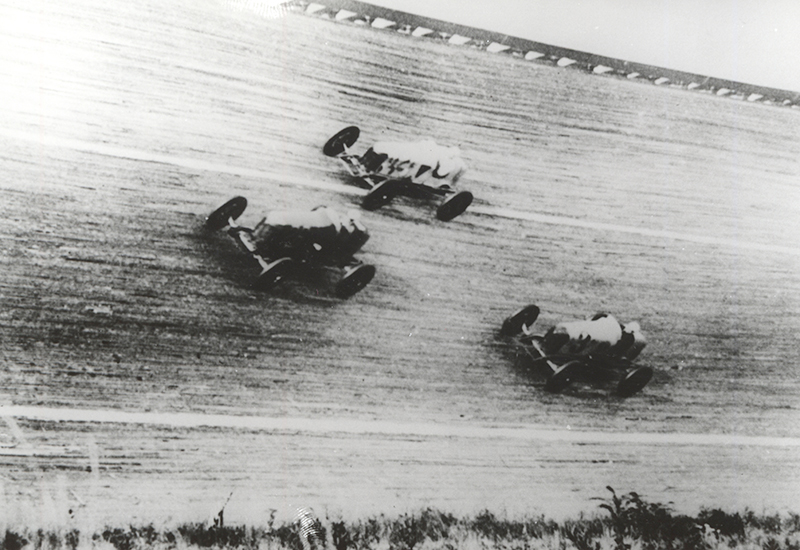News

|
04/19/2020
BOARD TRACK RACING IN NEW ENGLAND
Before there was paving, the fastest America's race tracks were built of lumber. New England had two board tracks and both were built by Jack Prince who built board tracks all over America. Both tracks were very steeply banked and both were incredibly dangerous. Motorcycle racing in Springfield Jack Prince went from bicycle racing to motorcycle racing where he built and opened a one-third mile-around fully circular track for motorcycle racing in Springfield, MA. No so coincidentally, Springfield was where George Hendee manufactured Indian motorcycles. Hendee provided the land and likely provided financing for Prince's track which opened on August 1, 1909.
The Springfield track, like others that were similar, was called a "Motordrome,." It was banked 40-degrees and photos show it's surface was anything but smooth. The track was by all accounts state of the art at the time, fully round so the bikes didn't have to slow down to enter corners. That produced higher overall speeds. The Springfield track was so well received that the day following the inaugural race, the local Springfield paper headlined "Great Spectacle at Opening of New Stadium" complete with a large photo. The majority of competitors rode Indian motorcycles. Many records were broken in early Springfield racing where Jake DeRosier re-captured the world's record for the mile averaging 85.71 MPH over three laps. Dozens of similar board tracks for motorcycles were built in Newark, NJ; Columbus, OH; Oakland, CA; Cleveland, OH; Salt Lake City, UT; Dallas, TX; st Louis, MO and other places. Motorcycle racing on high-banked board tracks was profoundly dangerous to riders and spectators. One of the most horrid days of motorcycle racing occurred on July 30, 1913 when Odin Johnson lost control of his motordrome bike and crashed into the wall. His gas tank ruptured and a huge fire broke out. Ultimately Johnson and nine spectators were killed. The accident followed and preceeded many others, some of them ending the lives of the most popular and successful riders. Motodromes began to be called ‘murderdromes' by the newspapers. With so much violence and death, the crashes became too much for the motordromes to survive. Among the contributing factors to danger was that the bikes had no brakes. Tire failure was the cause of many of the crashes. Eddie Brinck lost his life racing the Springfield track. Auto racing on the Rockingham Boards With his motordrome background, Jack Prince built larger board tracks suitable for auto racing. One of them was on the grounds of what had been a 1-1/4-mile dirt track in Salem, NH. The track came to be known as the Rockingham Boards. The dirt track was built by Jack LeCain who brought big names and a big crowd to come to see them. The quality of the field and size of the crowd persuaded LeCain that a state-of-the-art auto racing board track in Salem would be a hit on the same property.
With the success of the dirt track as background, he was able to find investors to finance the 49-degree bank board track that opened in October 1925. A harbinger of the future, the race was troubled. It was postponed twice before running on a bitter cold day with Peter DePaolo the winner. The first race weekend produced the track's first fatality when a crew member who was running to his driver who had crashed when he was struck and killed by another race car. Two race weekends were run in 1926 with smaller crowds than in 1925 and another fatal accident. This time local driver John Foley lost his life. Big name drivers Frank Lockhart and Harry Hartz were the winners.
By 1927, speeds were over 144 MPH but were seen by crowds that were again smaller than in the prior year. The track and local newspapers weren't getting along so there was little advance publicity. By the October race date, the track's mortgage had been foreclosed. And Harry Hartz was terribly injured in a career-ending crash. Peter DePaolo won in July. There were two races in October and Frank Lockhart won both. 1928 brought a new investment team, another fatality (Fred Comer whose car violently rolled, striking its driver) and there were other huge wrecks. The crashes were so grim, some fans had enough and walked out. Ray Keech won in July. The October race was called short of its advertised distance due to weather and never completed. Cliff Woodbury was declared the winner. In all, the Rockingham track ran just seven programs. There were three fatal accidents in those seven race weekends. As an undercard, motorcycle races also took place on the Rockingham Boards. The Rockingham Board track was torn down in 1929, replaced by the dirt track that preceded it. It's said that there are buildings in the area that have lumber with visible skid marks. The dirt track that followed was run successfully for several years before being repurposed for horse racing only. Please run the book cover with the following copy at the end of the story: It is with gratitude that I thank Don Emde for creating his magnificent book, "The Speed Kings," the story of American board track motorcycle racing. That book was the source for the motorcycle content in this story. The book is an interesting read, includes rich photography and is available at Emdebooks.com. Joe Freeman, a member of the museum's Board of Directors, is the leading authority on the history of the Rockingham, NH Board track. He wrote the chapter on that track in Dick Wallen's "Board Tracks: Guts and Glory," the definitive book on board track auto racing which is available at Coastal181.com.
Emde provided the motorcycle photos; Freeman provided the Rockingham photos. We thank them both. Back |



